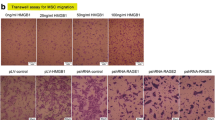Summary
In order to investigate the origin of neointimal smooth muscle cells in transplant arteriosclerosis in rat aortic allograft, sex-mismatched bone marrow transplantation was performed from male Wistar rats to female Wistar rats. Four weeks after transplantation, the aortic transplant model was established by means of micro-surgery in rats. The recipients were divided into 4 groups: female Wistar-female Wistar aortic isografts, female SD female Wistar aortic allografts, male SD-male Wistar aortic allografts, female SD-chimera Wistar aortic allografts. Eight weeks after transplantation, aortic grafts were removed at autopsy and processed for histological evaluation and immunohistochemistry. The results indicated that excessive accumulation of α-SMA-positive smooth muscle cells resulted in significant neointima formation and vascular lumen stricture in rat aortic allografts. Neointima assay revealed that the neointimal area and NIA/MA ratio of transplanted artery were significantly increased in all of aortic allograft groups as compared with those in aortic isograft group (P<0.01). Neointimal smooth muscle cells were harvested from cryostat sections of aortic allograft by microdissection method. The Sry gene-specific PCR was performed, and the result showed that a distinct DNA band of 225 bp emerged in the male-male aortic allograft group and chimera aortic allograft group respectively, but not in the female-female aortic allograft group. It was suggested that recipient bone-marrow cells, as the origin of neointimal smooth muscle cells, contributed to the pathological neointimal hyperplasia of aortic allograft and transplant arteriosclerosis.
Similar content being viewed by others
References
Sayegh M H, Carpenter C B. Transplantation 50 Years Later—Progress, Challenges, and Promises. N Engl J Med, 2004,351(26):2761–2766
Lechler R I, Sykes M, Thomson A W et al. Organ transplantation—how much of the promise has been realized? Nat Med, 2005,11(6):605–613
Joosten S A, Sijpkens Y W, van Kooten C et al. Chronic renal allograft rejection: pathophysiologic considerations. Kidney Int, 2005,68(1):1–13
Zalewski A, Shi Y, Johnson A G. Diverse origin of intimal cells: smooth muscle cells, myofibroblasts, fibroblasts, and beyond? Circ Res, 2002,91(8):652–655
Song Z F, Zheng Q C, Shu X G et al. The study on the potentiation of recipient cells involved in neointimal hyperplasia in rat aortic allograft. Chin J Exp Surg (Chinese), 2006,23(4):534–536
Libby P, Pober J S. Chronic rejection. Immunity, 2001,14(4):387–397
Joosten S A, van Kooten C, Paul L C. Pathogenesis of chronic allograft rejection. Transpl Int, 2003,16(3):137–145
Religa P, Bojakowski K, Bojakowska M et al. Allogenic immune response promotes the accumulation of host-derived smooth muscle cells in transplant arteriosclerosis. Cardiovasc Res, 2005,65(2):535–545
Sinclair A H, Berta P, Palmer M S et al. A gene from the human sex-determining region encodes a protein with homology to a conserved DNA-binding motif. Nature, 1990,346(6281):240–244
Bradbury M W, Isola L M, Gordon J W. Enzymatic amplification of a Y chromosome repeat in a single blastomere allows identification of the sex of preimplantation mouse embryos. PNAS, 1990,87(11):4053–4057
Author information
Authors and Affiliations
Additional information
SONG Zifang, male, born in 1975, M.D., Ph.D., Doctor in Charge
This project was supported by grants from the National Natural Sciences Foundation of China (No. 30271242, 30371396).
Rights and permissions
About this article
Cite this article
Song, Z., Li, W., Zheng, Q. et al. The origin of neointimal smooth muscle cells in transplant arteriosclerosis from recipient bone-marrow cells in rat aortic allograft. J. Huazhong Univ. Sc. Technol. 27, 303–306 (2007). https://doi.org/10.1007/s11596-007-0322-8
Received:
Issue Date:
DOI: https://doi.org/10.1007/s11596-007-0322-8




